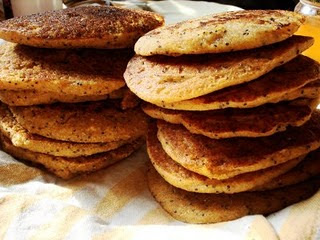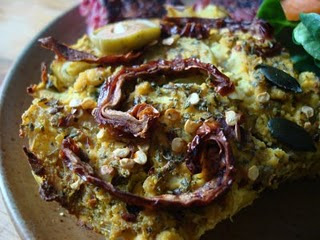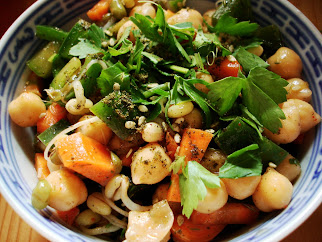The Son of Franken-Crepe: Erin's Kitchen Disaster
>> Saturday, February 28
Hint: the direction of the wood grain and the spatula are not the answers we were looking for
I realized yesterday, reading over squeaky mouse’s blog for dessert ideas, that I should confess something. I often…OFTEN…mess things up in the kitchen. It’s part of the process, and none of the recipes here would exist without the 3 mutilated versions immediately prior. The convenience of blogging is, I can post whichever picture I want. But just for a change of pace, let’s see the other side of Erin’s kitchen today.
I’m in pancake mania, and being home sick isn’t helping anything. Someone, tell me, what do you do when you’ve got 500 recipes to try, most of them involve fermented doughs, you’re bored out of your mind (even though you have many better things to do), and it’s breakfast time? Shhh…you’re not actually supposed to give an answer. I like mine. You make fermented buckwheat crepes.
I made the batter yesterday as an experiment because we’re planning some sourdough pancakes this weekend (the binge has no end in sight). It’s been sitting in the living room doing its yeast-gathering thing, and is definitely not a bubbly sourdough starter today, but it’s got a nice eggy texture that was wholly unexpected. I’ve got some leftover Country Corn and Potato Stew (recipe forthcoming), also unexpected, so we’re kickin’ it Erin style and slapping two completely unrelated food items together for a single-serving breakfast, just because we can.
Basic Recipe
Makes 1 mini crepe and 1 shriveled bat-ear look-alike. A useful quantity for 1 not very hungry child
Put1 tbsp canola oil, a dash of salt, and a grind of pepper into a jar.
Add in about 1/3 cup of your fermenting starter (chickpea and buckwheat flour with water, left to sit overnight), which you weren’t supposed to use for another 2 days.
Add a splash of water to get the consistency right, and if you have water kefir or kefir whey handy, use that instead to get some tang in there.
Heat the pan (mine is nonstick, and I didn’t oil it) for about 1 millisecond and toss 1 spoonful (clearly not enough) batter into the pan. Pause thoughtfully as you realize your mistake, then drizzle more batter around the original plop, and turn the pan to coat the bottom, which won’t work because the center is already firmed and the outside is still to runny. Don’t worry, it’s all part of the plan.
Because it seems better to get this painful thing out of the way as quickly as possible, flip the bat-ear before it’s even lightly browned. It should gum up on the spatula, stick to the bottom, and break in multiple places. Then you can attempt to cleverly fold it in half, because…Jesus, I have NO idea why. It seemed logical at the time, but I can’t justify that at ALL. This will make things worse, because it has now dried out too much to fold, and in a fit of panic, you can heave the thing onto the table “tsk” ing. Whisper: “Curse you, you crepe-bastard…”
Don’t worry, we’re almost done. Then you can turn the heat up to just over medium, mix a little more water into the batter, and dump it all into the pan. Amazingly, miraculously, like wine from water, the puddle of monster goo blooms into a lightly sizzling crepe, which, a few seconds after pouring, is ready to be gracefully flipped onto it’s white belly and cooked to golden perfection.
Serve with warmed leftover stew and a few finely chopped leek greens on top. Mop up the liquid left on your plate with the leathery mutant crepe, because one small crepe is not very much food and it's already too late to make something else. Bonus: you've eliminated the evidence of just how badly you can cook.
Check back tomorrow for the perfected recipe of sourdough buckwheat crepes! Read more...







































